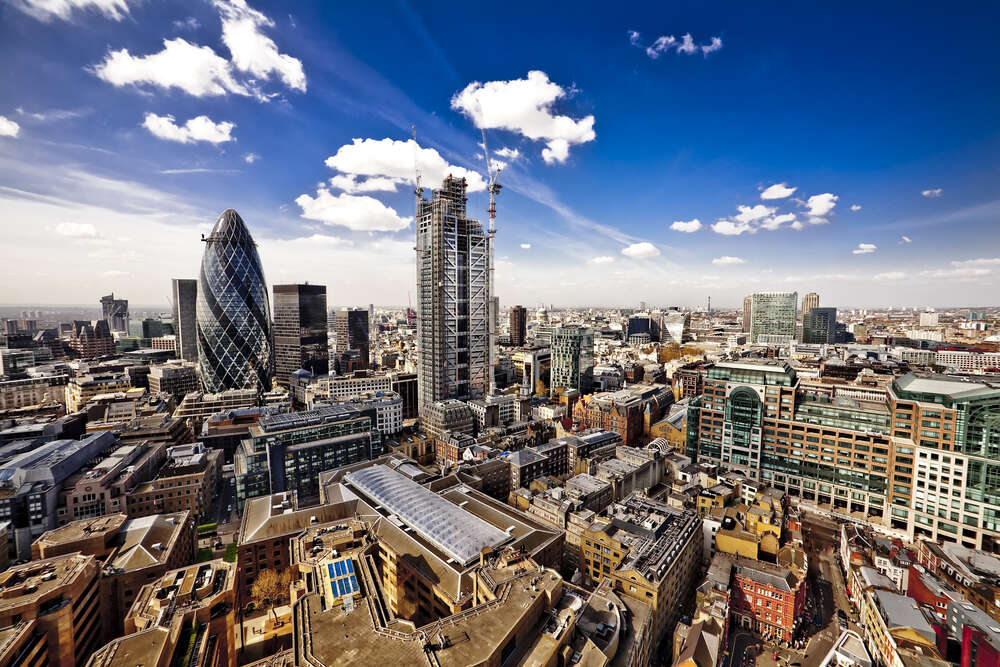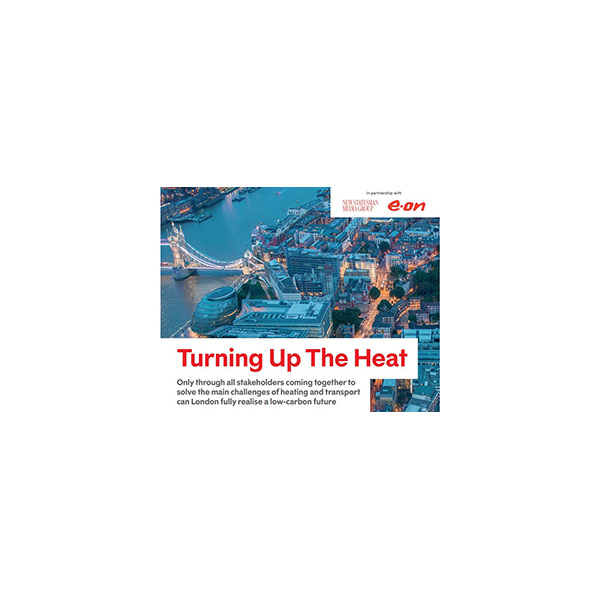
An intent to address the climate crisis and accelerate the energy transition via decarbonisation is more than evident across London. Some 27 boroughs and the City of London Corporation have now passed climate emergency declarations, as well as published action plans outlining how they will reach climate targets. Mayor Sadiq Khan has declared the ambition for the UK capital to reach net zero by 2030.

Hitting these increasingly ambitious targets will require a patchwork of efforts, combining initiatives at local, regional and national levels. Success will also be dependent upon the engagement and collaboration of a wide range of stakeholders, including central government, local councils, industry, commerce and residents. Huge strides are already evident, but the speed of change is only going to accelerate.
This is particularly applicable to how we source and secure our heat. While much progress has been made in the decarbonisation of electricity generation in recent years, transforming how we heat our buildings provides a specific challenge. After all, more renewables powering the grid makes little impact upon the resident turning on a light switch, but changing home heating systems in millions of homes requires significant retrofitting and expenditure – not to mention engagement and regular communication with the general public
At a national level, sustainable energy provider E.ON sees 60% of this heat decarbonisation challenge being addressed by the installation of individual heat pumps in homes, with hydrogen and heat networks accounting for an even share of the remaining 40%.
In our inner cities, however, heat networks are likely to account for a more significant (and a more cost-effective) proportion. This is already happening, but rapid growth depends on the right frameworks being put in place and participants who are properly incentivised to engage.
How London could harness waste heat
Heat networks, often described as “central heating for cities”, supply heat from a central, often local, source to consumers via a network of underground pipes carrying hot water. They remove the need for boilers or electric heaters in individual properties and are one of the most cost-effective ways of reducing carbon emissions from heating, harnessing and using excess heat that would otherwise go to waste. Once a network is installed, such waste heat can be fed back into the system from a variety of connected sources, including local industry and energy-intensive businesses, as well as natural sources such as rivers and canals.

District heating is particularly suited to high-density, built-up areas, with Antony Meanwell, E.ON’s head of decarbonisation for its City Energy Solutions division, pointing to inner-city boroughs like Newham and Tower Hamlets as prime candidates for benefitting from such schemes. The former hosts a university, hospital and hotels, and has an extensive pipeline of housing developments, an airport and a large industrial presence. All represent extensive potential sources of waste heat.
“There are a lot of industrial processes at play creating heat that is effectively wasted and released into the atmosphere,” Meanwell says of Newham. “Being able to utilise that is a great way of delivering cost-effective and low-carbon heating to residents.
“Tower Hamlets next door is the data centre capital of the UK. There’s potentially enough waste heat that could be captured and repurposed to heat the entire borough. Elsewhere you have large-scale installations such as waste plants and sewage treatment works. All of these could be utilised to supply heating systems.”
But for now, at least, much of this is theoretical. As things stand, only 2% of homes in the UK are supplied by heat networks. The Climate Change Committee has said that, with proper government support, this proportion could rise to 18% by 2050 (the equivalent of going from 450,000 to five million homes), but efforts remain in their relative infancy.
“To get there will require radical change,” Meanwell declares. “A fundamental is heat zoning, designated areas within which heat networks have been identified as the lowest cost, low-carbon solution for decarbonising heating. Without the necessary regulation, we’ll not see the step changes required. Then it comes down to ensuring participation is incentivised correctly and the heat zones that are built deliver the value that’s required. Heat networks become more efficient the more users they have. If they’re under-utilised you don’t get that efficiency.”
The decarbonisation legislative picture
Heat Networks Regulation was a feature of the Energy Bill, introduced to the UK Parliament in July of this year. It had promised to both “kick-start the development of heat networks” and offer protection to those using them, empowering local government to designate heat network zones and mandate relevant buildings to connect to nearby networks.

Such buildings include public sector and commercial organisations consuming more than a certain amount of heat, alongside existing and new residential developments. In addition, buildings with waste heat would also be mandated to connect to and supply the network.
The ambition was to have this enshrined in law by 2024, with the first 15 designated zones constructed in 2025. However, the bill has been paused by the government – and is even in danger of being scrapped completely.
Meanwell stresses the importance of the Energy Bill coming back to Parliament soon, but is also keen to stress that this is still only the start of the journey. A heat network is by its very nature a collaborative project. Engagement is paramount, but the lack of a clear framework can make the message hard to articulate.
“Part of the problem is that we don’t have a fully thought-through action plan for heat decarbonisation in place,” he explains. “We have the heat and buildings strategy, but we also need government to clearly lay out its ambition, where it wants to go and, more importantly, by when. If there was confidence that this direction of travel was supported cross-party for the long term, that would enable investors; the likes of E.ON, local authorities, manufacturers, universities – everybody in this ecosystem – to understand the direction of travel and requirements for getting there. Nobody is going to prepare properly if they don’t know where they’re going or by when.”
The other part is how to incentivise and support individuals and businesses to participate in the journey. Meanwell believes this does not necessarily require the creation of new funding schemes, but more the repackaging of existing ones. He points to examples such as the Social Housing Decarbonisation Fund, the Public Sector Decarbonisation Scheme, the Home Upgrade Grant, the Green Homes Grant Local Authority Delivery Scheme, ECO4 and the Boiler Upgrade Scheme, all of which provide grant funding for heat pumps that could be redirected in a heat zone.
“There is a need to grow the number of residential connections, but the government doesn’t want to mandate participation,” he explains. “We need to look at those incentives and, where people can access £5,000 to £10,000 for a heat pump, and ask whether that money would be better spent on connecting to a heat network. Heat zoning, therefore, provides clarity and certainty to investors and homeowners on what future heat options are right for which area.
“If we spend all this money on installing large-scale heat infrastructure, only for residents to still go down the route of installing individual heat pumps, we’ll soon have to upgrade the electrical infrastructure as well. That doesn’t seem like a smart way of spending money.”
A similar argument around unnecessary additional expenditure can be made against hydrogen, the other main possibility for decarbonising heat, though as yet this is someway off commercial viability. While hydrogen has a significant part to play at a national level, concerns have been raised over the cost both of installing the requisite infrastructure and final energy prices for the end user.
A patchwork of decarbonisation efforts
Amid all this talk of expenditure on incentivisation, however, there is also a significant opportunity for economic stimulus. Hitting the 18% by 2050 ambition for heat networks will require £60–80bn of investment, potentially creating 30,000 new jobs and engendering significant skills development. This emerging front of the green economy stands to hugely benefit local authorities who engage early.
And heat networks form just one front of the decarbonisation battle. Indeed, they can only make a full impact if part of a wider patchwork of efforts to upgrade existing infrastructure and housing stock is made. “When connecting to a heat network, the lower you can make temperature requirements, the more efficiently it will work,” Meanwell explains. “Anything we can do to ensure to reduce a building’s requirements, the greater the gains.”
In consultations with residents, Meanwell has found the best engagement strategy is to talk about heat networks within the context of wider improvements that can be made to households. He points to E.ON’s work with GreenSCIES in Islington, a consortium of 16 organisations looking at delivering smart energy systems to the borough.
“One of the things that comes out loud and clear is that if you’re going to enter their homes to replace their boiler, then you also need to make sure you’re tackling other issues within that property,” he says.
“If it’s poorly insulated, draughty, damp – they want to see all of this tackled together. We need to retrofit district heating into existing housing stock if we’re to hit the five million homes figure, but that should come within the context of a whole-house approach.”
Listening to communities, sharing best practices, leveraging existing initiatives and combining efforts will all go a long way towards defining success. Meanwell cites city-wide networks in locations such as Sweden, Germany and Poland, where models and precedents have been established, as valuable learning tools.
“If we are going to hit net zero, we have to be open, work together and make sure we bring everybody along with us,” he says. “There needs to be a joined-up, coordinated approach that encompasses both specific initiatives and efforts, and the bigger picture. Everyone has a role to play.”
For more details on opportunities for decarbonisation across London, go to eonenergy.com/decarbonising-london.







